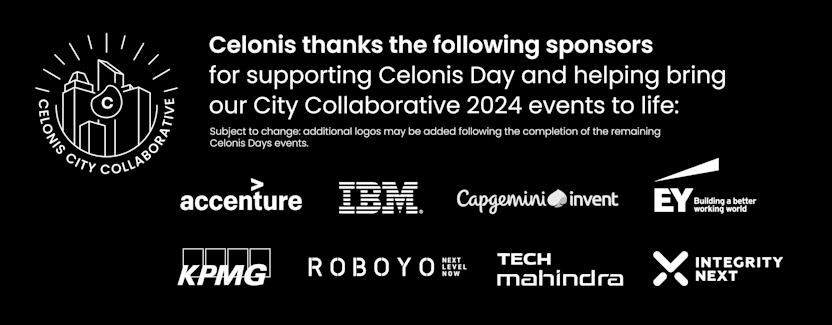
AI and Process Intelligence: Insights from industry leaders at Celonis Day
Businesses are using AI to adapt to today’s challenges, and process intelligence is critical for effective enterprise AI. Those were the takeaways from a fireside chat between R “Ray" Wang, CEO of Constellation Research, and Alexander Rinke, co-CEO and co-founder of Celonis, during the Celonis Day Bay Area event. Held in San Francisco, the gathering was part of Celonis City Collaborative 2024, an event series spread across 23 cities and 4 continents to showcase the power of process intelligence. During their conversation, Wang and Rinke discussed the macro issues facing businesses, process mining and process intelligence’s role in AI, and the keys for business success with AI.

R “Ray" Wang (left) and Alexander Rinke (right) during a fireside chat at Celonis Day Bay Area 2024 in San Francisco.
Era of margin compression and AI arbitrage
Wang set the stage by highlighting several major trends and challenges facing businesses. These include:
Decarbonization efforts
Changes in supply chains due to deglobalization
Seeking exponential efficiency gains
Margin compression in various industries
Population dynamics and aging workforces
Interest rate impacts on investment decisions
Geopolitical uncertainty
Wang emphasized the importance of digitization and what he calls "AI arbitrage" in addressing these challenges. We're in an era of “margin compression” Wang noted, explaining how AI and process intelligence can help companies navigate this new landscape. He introduced the concept of "decision velocity," stating, "Machines make rapid decisions. In fact, machines can make hundreds, even thousands of decisions per second. And it takes us forever to get it out of our human processes. And the companies that can make faster, more precise decisions over time are the ones that are going to have an exponential advantage and win."
Yet, Wang emphasized that AI models need to get better and human decision making is still crucial. Current LLMs (large language models) can deliver 85%-95% accuracy. But that’s not good enough, Wang noted. Querying the crowd, he asked:
“Who thinks 85% accuracy is good for customer experience? It's pretty good, right? Not bad. Who thinks 85% accuracy is good for supply chain? Anyone? No. Your manufacturing operations will fall. Who thinks 85% accuracy is good for finance? Anybody want to go to jail? Who thinks 85% accuracy is okay for healthcare? It's not, right? And so we're going to have to get smarter and smarter about this.”
To get that last 15%, Wang said businesses not only need more data, but the right kind of data—the kind that comes from process intelligence. At the same time, businesses will need to determine how to include humans in the process. “The most important question you and I will be asking in the future is not, ‘Where do we automate?’” he said. “It's going to be ‘When and where do we insert a human in the process?’ Because we're never going to get to 95% or 99% accuracy, [so] we're going to have to know when we apply human judgment.”
Process intelligence enables effective enterprise AI
The conversation then turned to the critical role of process intelligence in the age of AI. Rinke emphasized the critical need for context in AI implementations. "There's no Wikipedia for your process in your company," he said. "There's no central place where high-quality information about your business processes exists. And those AI agents will need that in order to help you and help your customers."
As I wrote recently: “Consumer AI works because it has both a wealth of data to train on (books, articles, web pages) and the context necessary for it to understand how all those raw data points relate to each other (Wikipedia, online archives, etc.). This is often not the case in the enterprise, where there’s plenty of raw data from business systems (ERP, CRM, etc.), but no Wikipedia-like reference to connect all that disparate information. Process intelligence provides this connection—the unique business context necessary to enable effective enterprise AI.”
The Process Intelligence Graph (PI Graph), which sits at the heart of the Celonis platform, builds a system-agnostic digital twin of a business and couples it with the unique business context within which the organization operates (what makes something “good” or “bad” for the organization). The PI Graph shows how a business is running and where and how things could run better. For example, it enables businesses to answer questions like, ‘Which orders are prone to late delivery?’ and ‘How do late deliveries impact customer satisfaction?’”
The Celonis platform feeds these process insights into an organization’s existing AI toolset of agents, copilots, and applications. It also uses this context to power its own set of copilots, AI apps, and custom AI solutions.
Both Rinke and Wang agreed on the importance of starting with low-hanging fruit when implementing AI solutions. They suggested areas like accounts payable and order management as good starting points. "Celonis will be an important part of the AI equation by enabling AI in all sorts of forms and fashions,” said Rinke.
Our AI-enabled future and 4 questions business should ask before an AI PoC
Looking to the future, Wang and Rinke discussed the potential for AI to transform user experiences and automate process steps in a more flexible way than traditional RPA.
“RPA was great, but you can only deploy so many bots,” Rinke said. “You need to put a lot of time into configuring them, and then they're pretty rigid.” Instead, AI (enabled with process intelligence) allows businesses to create smart agents that automate steps in a process. For example, if an AI agent can handle the vast majority of invoice payments, humans can focus on the exceptions.
And increasingly when humans and machines do collaborate, either on process exceptions or on other tasks, the interface will be dramatically different from those of today’s business systems. "I think the user experience is going to be AI-enabled. And at some point, UIs will go away, and we’ll just talk to computers," Rinke predicted.
To achieve this vision, companies need an intelligent orchestration layer on top of their existing systems that brings all their siloed data together. “You've got a silo in CRM, a silo in ERP, a silo in the supply chain, a silo in your registry systems,” said Wang. “We need abstraction layers.” The orchestration layer also enhances human control of the process by allowing people to focus on high-level work that requires deeper knowledge and understanding.
Wrapping up the conversation, Wang suggested businesses answer four questions before jumping into their own AI proof of concept:
Where will you find the data that you need?
What business problem are you really trying to solve and is it worth your time?
What's the business model behind what you're doing?
Where do you put a human in the loop?
As Wang put it, the winners 10 years from now will be the companies that use AI to successfully transform their business model and the customer experience.




